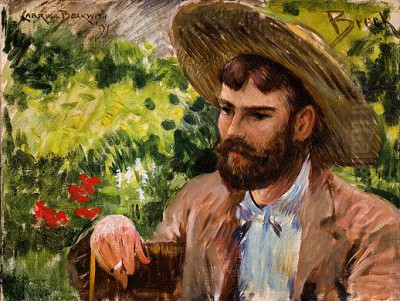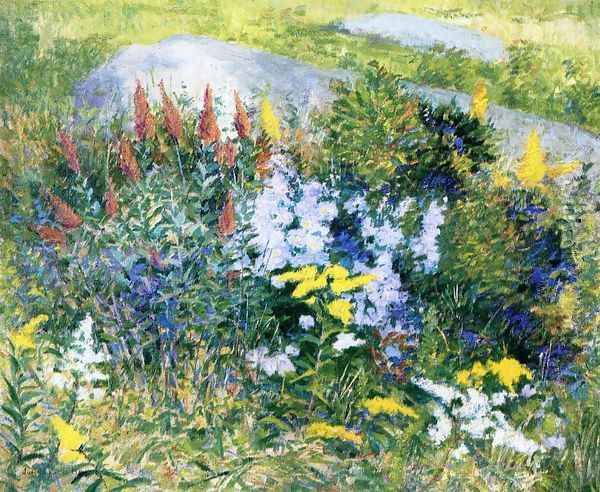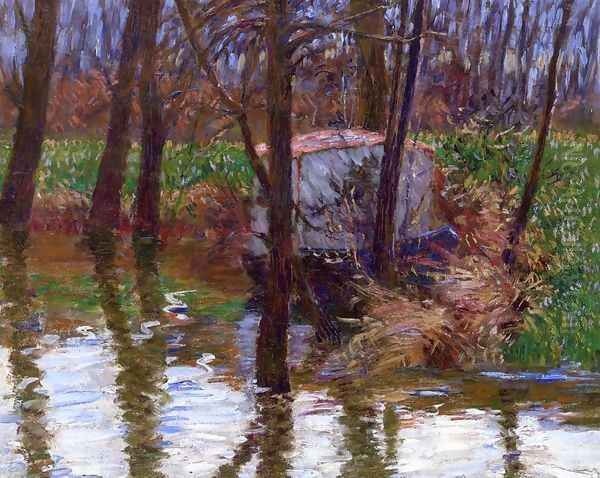
John Leslie Breck stands as a seminal, albeit sometimes overlooked, figure in the annals of American art history. Often hailed as one of the very first American painters to fully embrace and champion the revolutionary tenets of French Impressionism, Breck played a crucial role in introducing this vibrant, light-filled aesthetic to the United States. His relatively short life was marked by intense artistic exploration, significant European experiences, and a dedication to capturing the fleeting effects of light and atmosphere in his landscapes. Though his career was tragically cut short, his legacy endures through his luminous canvases and his undeniable impact on the generation of American artists who followed.
Early Life and Artistic Awakening
John Leslie Breck was born on April 10, 1860, not in the artistic hubs of Europe or America, but rather exotically, aboard an American clipper ship captained by his father, a naval officer, near the British Crown Colony of Hong Kong. This adventurous beginning perhaps foreshadowed a life that would involve significant travel and cross-cultural artistic immersion. His early childhood, however, was spent in a more conventional New England setting. Following his father's retirement from the sea, the Breck family settled in Newton, Massachusetts, a suburb of Boston.
It was in this environment that Breck's artistic inclinations began to surface. He received his initial art instruction in Boston, a city with a burgeoning, if somewhat conservative, art scene. Recognizing his talent and ambition, his family supported his decision to pursue formal art training abroad, a common path for aspiring American artists of that era seeking to immerse themselves in the established traditions and exciting new movements of European art.
European Sojourn: Academic Foundations and New Horizons

In 1877, at the age of seventeen, Breck embarked for Europe, a journey that would profoundly shape his artistic trajectory. His first significant stop was Munich, Germany, where he enrolled in the Royal Academy of Fine Arts. Munich was then a major center for art education, known for its rigorous academic training, emphasizing strong draftsmanship, a dark, tonal palette, and often historical or genre subjects, influenced by the Dutch Old Masters. Here, Breck would have honed his foundational skills, learning the traditional techniques that were considered essential for any serious painter.
After his studies in Munich, Breck, like many of his American contemporaries, was drawn to Paris, the undisputed capital of the art world in the late 19th century. He enrolled at the prestigious Académie Julian, a private art school popular with foreign students, including many Americans. At the Académie Julian, he studied under noted academic painters such as Gustave Boulanger and Jules-Joseph Lefebvre. These instructors perpetuated the classical ideals of the French Salon, focusing on meticulous rendering, idealized forms, and grand historical or mythological themes.
Breck also spent time in Antwerp, Belgium, studying with Charles Verlat, another proponent of academic realism. This period of rigorous academic training provided Breck with a solid technical grounding. However, the artistic ferment of Paris, particularly the burgeoning Impressionist movement, was beginning to capture the attention of younger, more adventurous artists. While the academies preached tradition, a revolution in light and color was unfolding just outside their doors.
The Giverny Revelation: Embracing Impressionism
The pivotal moment in John Leslie Breck's artistic career, and indeed for the introduction of Impressionism to America, occurred in the summer of 1887. Breck, along with a group of fellow American artists including Willard Metcalf, Theodore Robinson, Louis Ritter, Henry Fitch Taylor, and Theodore Wendel, made his way to Giverny. This small village in Normandy had recently become the home of Claude Monet, the leading figure of French Impressionism.
The American artists were drawn to Giverny by the allure of Monet's presence and the picturesque landscape. Breck was among the very first of this wave of American painters to settle in Giverny and to form a close association with Monet. He quickly befriended the Monet family, and this relationship proved to be transformative. Under Monet's direct influence and inspired by the master's revolutionary approach to painting, Breck began to shed his academic training.

He embraced the core principles of Impressionism: painting en plein air (outdoors) to capture the immediate sensory experience of a landscape, using broken brushstrokes and a palette of bright, unmixed colors to convey the fleeting effects of light and atmosphere. He learned to see and depict the world not as a collection of static objects, but as a constantly shifting interplay of light, color, and reflection. This was a radical departure from the dark, tonal paintings and meticulous finish of his academic training.
Breck and the American Impressionist Circle in Giverny
Breck became a central figure in the burgeoning American art colony at Giverny. He, along with Theodore Robinson, who also developed a close mentorship with Monet, was one of the earliest and most dedicated American converts to the Impressionist style. The presence of these artists transformed Giverny into a significant outpost of American art in Europe. They painted the local scenery – the fields of poppies, the winding River Epte, the haystacks, and Monet's famous garden – all filtered through the new lens of Impressionism.
During his time in Giverny, Breck developed a romantic relationship with Monet's stepdaughter, Blanche Hoschedé-Monet, who was herself an aspiring painter working under Monet's tutelage. This personal connection further immersed Breck in Monet's world and artistic philosophy. While the relationship eventually ended, causing Breck to leave Giverny for a period, its impact on his artistic development was profound.
The Giverny period, from 1887 to roughly 1891, was incredibly productive for Breck. He created a series of paintings that demonstrated his rapid assimilation and mastery of Impressionist techniques. His work from this time is characterized by a vibrant palette, a sensitivity to atmospheric conditions, and a focus on capturing the ephemeral beauty of the French countryside. He was particularly interested in Monet's concept of "series" paintings, where the same subject was depicted multiple times under different light and weather conditions, and Breck produced his own series, most notably of grainstacks, echoing Monet's famous Haystacks series.
Artistic Style and Thematic Concerns
John Leslie Breck's mature artistic style is a testament to his wholehearted adoption of Impressionism, yet it retains a certain American sensibility. While he embraced the broken brushwork, bright colors, and emphasis on light characteristic of French Impressionism, his compositions often maintained a degree of structural solidity that perhaps harked back to his academic training or reflected a more American preference for clarity.
His primary subject matter was landscape. He was deeply attuned to the nuances of the natural world, from the gentle hills and rivers of Giverny to the coastal scenes of his native Massachusetts and, later, the shimmering canals of Venice. Breck was a master of capturing atmospheric perspective, conveying a sense of depth and space through subtle gradations of color and tone. His skies are often dynamic and expressive, playing a crucial role in establishing the mood and light of a scene.
Color was paramount in Breck's work. He moved away from the somber earth tones of his early training to a palette rich in blues, greens, violets, yellows, and pinks, applied with a vivacity that brought his canvases to life. He was particularly adept at depicting the interplay of sunlight and shadow, the sparkle of light on water, and the changing hues of the landscape throughout the day and across the seasons. His brushwork, while clearly Impressionistic, could vary from short, staccato dabs to longer, more flowing strokes, depending on the texture and form he was rendering.
Key Works: Capturing Light and Landscape
Several of Breck's paintings stand out as exemplars of his Impressionist vision. Garden at Giverny (c. 1887-1891), also sometimes titled Monet's Garden, is a quintessential Giverny scene, likely depicting a corner of Monet's burgeoning paradise. It showcases his newfound freedom with color and light, capturing the lushness of the flowers and foliage with vibrant, energetic brushstrokes. The painting radiates the warmth and beauty of a summer day in the French countryside.
Another significant work, Essex River (1889) or similar New England scenes painted upon his returns to America, demonstrates his application of Impressionist techniques to American landscapes. These works often feature the distinctive light and atmosphere of the Massachusetts coast or countryside, rendered with the same sensitivity to color and fleeting effects that he developed in France.
His series of paintings depicting grainstacks, such as Studies of an Old Mill or Grain Stacks, Giverny, directly echo Monet's explorations of the same motif. These works show Breck's fascination with capturing the same subject under varying conditions of light and at different times of day, revealing the transformative power of atmosphere on perception. Autumn, Giverny (The New Moon) is another evocative Giverny landscape, showcasing his ability to capture a specific mood and time, with the subtle light of the new moon adding a poetic quality to the scene.
Later in his career, during his visits to Venice, Breck produced a series of stunning paintings, including nocturnes. Works like Santa Maria della Salute, Venice (c. 1896-1897) or The Bay at Venice (1897) capture the unique interplay of moonlight, water, and architecture in the iconic Italian city. These Venetian scenes are often imbued with a romantic, almost ethereal quality, demonstrating his continued exploration of light effects, even in more subdued, nocturnal settings. Flowers in a Garden (1892) further highlights his skill in depicting floral subjects with Impressionistic vibrancy.
Return to America and Championing Impressionism
John Leslie Breck returned to the United States periodically, and more permanently in the early 1890s. He brought with him not only a portfolio of dazzling Impressionist paintings but also a fervent belief in the new style. In 1890, he held a solo exhibition at the St. Botolph Club in Boston. This exhibition, featuring his Giverny landscapes, was a landmark event. It was one of the very first solo shows by an American artist dedicated entirely to Impressionism and it caused a significant stir in the relatively conservative Boston art world.
While some critics were perplexed or even hostile to this radical new style, with its "unfinished" appearance and bold colors, others recognized its vitality and truthfulness to nature. The exhibition was described by some as the "sensation of the art season." Breck's show, along with the efforts of other returning Giverny artists like Theodore Robinson and Willard Metcalf, played a crucial role in introducing and popularizing Impressionism in America. He continued to exhibit in Boston and New York, further promoting the style.
Breck's efforts were not limited to exhibitions. He also taught, sharing his knowledge and enthusiasm for Impressionism with a younger generation of American artists. He was, in a very real sense, a missionary for the Impressionist cause in America. His work influenced other Boston-based painters who would become known as the Boston School, artists like Edmund C. Tarbell and Frank Weston Benson, though they developed their own distinct variant of Impressionism. Other American Impressionists like Childe Hassam, J. Alden Weir, and John Henry Twachtman were also part of this broader movement, each contributing to its American adaptation. Even the great portraitist John Singer Sargent, an acquaintance of Breck, experimented with Impressionist techniques in his landscape work.
Later Years and Venetian Period
The 1890s saw Breck continue to paint and exhibit, though his personal life was not without its difficulties. He traveled again to Europe, including a significant period in Venice in 1896-1897. The city of canals, with its unique light and atmospheric conditions, provided new inspiration. His Venetian paintings, often depicting famous landmarks like Santa Maria della Salute or broader lagoon views, are characterized by a rich, sometimes more muted palette, and a focus on the reflective qualities of water. His nocturnes from this period are particularly noteworthy for their poetic and evocative qualities.
He also continued to paint in New England, capturing the landscapes of Massachusetts with his established Impressionist technique. His work from this period demonstrates a mature and confident handling of the style, consistently producing canvases that are both visually appealing and emotionally resonant. He maintained connections with fellow artists and continued to be a respected, if not yet universally acclaimed, figure in the American art scene.
Despite his artistic successes and his pioneering role, Breck's work did not always bring him the financial security or widespread recognition that some of his contemporaries achieved during their lifetimes. The art market and critical tastes were still evolving, and Impressionism, while gaining ground, was not yet fully embraced by all patrons and institutions.
Tragic End and Posthumous Recognition
John Leslie Breck's promising career and life were tragically cut short. He died on June 18, 1899, at the age of only 39, in Boston. The official cause of death was recorded as asphyxiation by illuminating gas. While the circumstances were somewhat ambiguous, there were rumors and suggestions that his death may have been a suicide, possibly linked to personal disappointments or ongoing struggles. This untimely end deprived American art of one of its most talented and forward-looking painters.
In the years immediately following his death, Breck's reputation somewhat faded from public view, overshadowed by other American Impressionists who lived longer and had more extensive careers. However, art historians gradually began to reassess his contributions, recognizing his crucial role as a pioneer who was among the very first to fully embrace and promote Impressionism in the United States. His close association with Monet and his early Giverny paintings gave him a unique and important place in the story of American art.
Major retrospective exhibitions, such as the one organized by The Mint Museum in Charlotte, North Carolina, in 2021, which later traveled to the Dixon Gallery and Gardens in Memphis and the Figge Art Museum in Davenport, Iowa, have played a significant role in reintroducing Breck's work to a wider audience and solidifying his status. These exhibitions brought together a substantial body of his work, allowing for a comprehensive understanding of his artistic development and achievements.
Legacy and Influence
John Leslie Breck's legacy is multifaceted. He is rightly considered one of the "Fathers of American Impressionism." His courage in adopting a radical new style, his dedication to its principles, and his efforts to promote it in America paved the way for its broader acceptance and development on American soil. He demonstrated that American artists could engage with the most advanced European art movements and adapt them to an American context.
His influence can be seen in the work of other American artists who were part of the Giverny colony and in the broader wave of American Impressionism that flourished in the late 19th and early 20th centuries. Artists like Theodore Robinson, Willard Metcalf, Lilla Cabot Perry (who also became close to Monet), and many others benefited from the trail blazed by early adopters like Breck.
His paintings themselves are his most enduring legacy. They are a testament to his keen eye, his sensitivity to light and color, and his ability to capture the beauty and poetry of the natural world. From the sun-drenched fields of Giverny to the misty canals of Venice and the familiar landscapes of New England, Breck's canvases invite viewers to share in his immediate, sensory experience of the world, rendered with a vibrancy and freshness that remains compelling today.
Breck's Works in Collections
Today, John Leslie Breck's paintings are held in numerous prestigious public and private collections, primarily in the United States. Key institutions that house his work include the Smithsonian American Art Museum (formerly the National Museum of American Art) in Washington, D.C., which holds important examples of his Giverny period. The Harvard Art Museums (specifically the Fogg Museum) in Cambridge, Massachusetts, also have significant Breck paintings.
Other notable collections include the Terra Foundation for American Art in Chicago, which has a strong focus on American Impressionism and holds several of Breck's works. The Musée des impressionnismes Giverny (formerly the Musée d'Art Américain Giverny) in France, appropriately, also features his work, acknowledging his importance to the Giverny art colony. Smaller museums with regional focuses, such as the Newton History Museum in his hometown of Newton, Massachusetts, and university museums like the former Ohio State University Museum of Art, also count his works among their holdings. The Carnegie Museum of Art in Pittsburgh and various private collections, such as the historic Daniel J. Terra Collection and the Pfeil Collection, further attest to the enduring appeal and art historical significance of his oeuvre. The recent major traveling exhibition originating at The Mint Museum has also helped to highlight works from various lenders, bringing many pieces to public attention.
Conclusion
John Leslie Breck's journey from a New England upbringing to the heart of the French Impressionist movement in Giverny, and his subsequent role in transplanting this revolutionary style to American shores, marks him as a figure of considerable importance. Though his life was brief, his artistic output was significant and impactful. He was a true pioneer, an artist who embraced change and dedicated his talents to capturing the ephemeral beauty of light and nature. As appreciation for American Impressionism continues to grow, John Leslie Breck's luminous landscapes and his pivotal role in art history are increasingly recognized and celebrated, securing his place as a vital link between French Impressionism and its vibrant American expression.